I still remember the first time I strapped on a headset and felt my heart flip — that sudden, odd mix of wonder and disbelief. It hit me how a computer-driven environment could make me forget the room around me.
This guide strips complex information into clear steps so you can use immersive technology without confusion. I’ll show how headsets, controllers, and sensors blend hardware and software to create presence — the true “I’m there” feeling.
Along the way I point to real examples you can try tonight, from entertainment demos to simple training scenarios that help people learn safely. I also cover timing and responsiveness, because a smooth system is what keeps an experience comfortable.
Stick with me and you’ll save time while learning practical tips I actually use. By the end, you’ll know what gear matters, how the computer side works, and where this reality technology shines today.
Key Takeaways
- I explain virtual reality in plain terms so beginners can follow.
- Learn how headsets and controllers work together to create presence.
- See practical examples for entertainment and training use.
- Understand why system timing matters for comfort.
- Find quick, real-world steps you can try right away.
What I Mean by a Beginner’s Guide to Virtual Reality
This guide gives you a clear path from the first headset setup to your first hands-on session, with tips that cut through the jargon.
I define a “beginner’s guide” as a plain-English route through core concepts. You’ll get simple definitions, visual cues to watch for, and clear starting steps so you know what to try first.
I explain the basics of how a computer-modelled 3D environment works in real time and how motion-tracked input lets users interact. This information helps you judge quality and comfort.
By the end you’ll understand core concepts, where to use these systems, and which applications match goals like learning or play. I map learning, education, creativity, and collaboration to real choices.
Think from a user view: what you’ll see, hear, and do, plus common mistakes to avoid. I call out key terms—presence, latency, tracking—and why they matter for a good experience.
- First principles, then practical steps so you can skim or read straight through.
- Tips for sharing and learning with friends or colleagues.
Virtual Reality
I want to explain how a three-dimensional, simulated world can convince your senses that you’ve stepped somewhere else.
Defining a computer-generated environment and presence
In plain terms, this is a computer-generated environment you can explore and interact with. Headsets show stereoscopic images that give depth and scale. Motion sensors update those images as you turn or move, creating telepresence.
That “presence” is the odd but useful feeling of actually being there. When timing and information flow match your motion, perception aligns and the illusion holds.
How it differs from augmented and mixed approaches
Augmented reality adds digital layers onto the physical world. Mixed setups let digital and physical objects interact in the same space. By contrast, virtual reality replaces the room with a fully immersive virtual environment.
“Early head-mounted displays and data gloves showed that matching motion to images is what convinces the brain.”
I mention pioneers like Ivan Sutherland and the VPL DataGlove to show how today’s systems evolved. Controllers and gloves enable direct interaction, from pointing to grabbing, so users feel agency in the virtual world.
- How interaction works: sensors, controllers, and haptics.
- Why vision and low latency shape comfort and believability.
- Where AR and MR fit in the broader field of immersive systems.
How VR Works: From Head-Mounted Displays to Telepresence
I’ll break down what each part of a headset setup does and why timing matters for comfort.
Core hardware includes a head-mounted display with stereoscopic screens, motion controllers, room or headset-mounted sensors, and optional data gloves for force feedback. Each device captures or displays signals so the system tracks your position and actions in real time.
Software and real-time inputs
Graphics and audio engines render images and sound and combine inputs from sensors and controllers. The system updates the view every frame so what you see matches your motion without distracting delay.
Tracking, degrees of freedom, and comfort
6DoF lets users move and rotate in space; 3DoF handles rotation only. 6DoF enables leaning, stepping, and natural interaction. 3DoF limits movement and feels less immersive.
| Component | Role | Common Specs | Effect on User |
|---|---|---|---|
| Head-mounted display | Shows stereoscopic images | 90 FPS, 100°+ FOV | Clearer vision, less fatigue |
| Motion controllers | Input hands/gestures | Low-latency tracking | Direct interaction, agency |
| Sensors / tracking | Position and orientation | 6DoF or 3DoF support | Stability and presence |
| Data gloves | Haptics and force feedback | Finger tracking, resistive feedback | Enhanced touch realism |
Latency, frame rate, and field of view are the technical must-haves. Low latency and high frame rate (often ~90 FPS) keep motion and vision aligned. A wide field that matches human vision reduces strain and helps presence form.
Presence emerges when hardware, software, and timing sync so users accept the computer-generated environment. If your eyes sense motion while your body does not, you may feel nauseous; good tracking and calibration avoid that.
Types of Virtual Reality Systems and Experiences
Different systems suit different goals. Some are simple screen-based setups, while others use headsets, controllers, and full spatial tracking. I’ll outline the main types so you can pick what fits your needs.
Non-immersive, semi-immersive, and fully immersive
Non-immersive systems show 3D content on a standard display. They work well for lightweight exploration, early prototyping, or sharing demos with a group.
Semi-immersive setups use large screens or simulators. Classrooms and training centers use them because they give more presence without requiring headsets.
Fully immersive systems use headsets, spatial tracking, and peripherals. These isolate you in a virtual environment and deliver the strongest sense of being in a different place.
AR and MR at a glance
Augmented systems add digital overlays onto the real world. They are great for informative tags, navigation, or light UX tests.
Mixed setups let digital objects interact with physical surroundings. MR supports manipulation and shared tasks where real and digital blend.
| Type | Typical Systems | Best Uses |
|---|---|---|
| Non-immersive | PC/console, monitor, basic controllers | Prototyping, demos, broad access |
| Semi-immersive | Large screens, simulators, projection walls | Classroom training, simulators, group learning |
| Fully immersive | Headsets, room sensors, hand tracking, haptics | Deep training, gaming, simulation practice |
| AR / MR | Mobile AR apps, AR headsets, MR systems | On-site overlays, interactive design, collaborative fieldwork |
- Peripherals: simple controllers work for non-immersive and semi setups; hand tracking and haptics suit fully immersive work.
- Developers tune interaction complexity to match system limits so users learn comfortably.
- Starter picks: a desktop 3D demo for non-immersive, a classroom simulator for semi-immersive, and an entry-level headset for full immersion.
The Gear I Recommend for Getting Started in the Real World
Picking the right gear makes your first sessions smoother and more fun.
Choose a head-mounted display that fits your budget and your system. An HMD uses stereoscopic screens and tracking to deliver 3D views. Field of view and frame rate matter more than raw marketing numbers for first-time users.
Comfort, fit, and setup tips for first-time users
Fit is simple but vital. Adjust the strap and counterbalance so the head weight sits steady. Set lens-to-eye distance and IPD for crisp vision and less strain.
Start with short, low-motion content to build tolerance. Add accessories—better audio, a light-blocking face gasket, or gloves for haptic feedback—only when the base setup feels right.
| Item | Why it matters | Quick spec to check | First-step tip |
|---|---|---|---|
| Head-mounted display | Shows stereoscopic 3D | 80–90+ FPS, wide FOV | Adjust IPD and strap before play |
| Controllers / tracking | Hand input and position | Low-latency tracking | Calibrate or re-pair if drift occurs |
| Audio & face gasket | Comfort and immersion | Closed audio, light-blocking seal | Test for pressure points and tweak fit |
| Gloves | Haptic interaction | Finger tracking, force feedback | Use after basic sessions are smooth |
- Setup checklist: clear play space, guardian boundary, quick calibration.
- Lens care and cable management extend comfort in longer sessions.
- Troubleshoot blurry visuals by re-seating the headset or adjusting IPD; fix controller drift by recalibrating.
VR in Action: Education, Training, Entertainment, and Industry
Hands-on simulations are the fastest way I know to turn theory into lasting skill. I’ll show how immersive systems move from demos into real classroom, workplace, and creative uses.
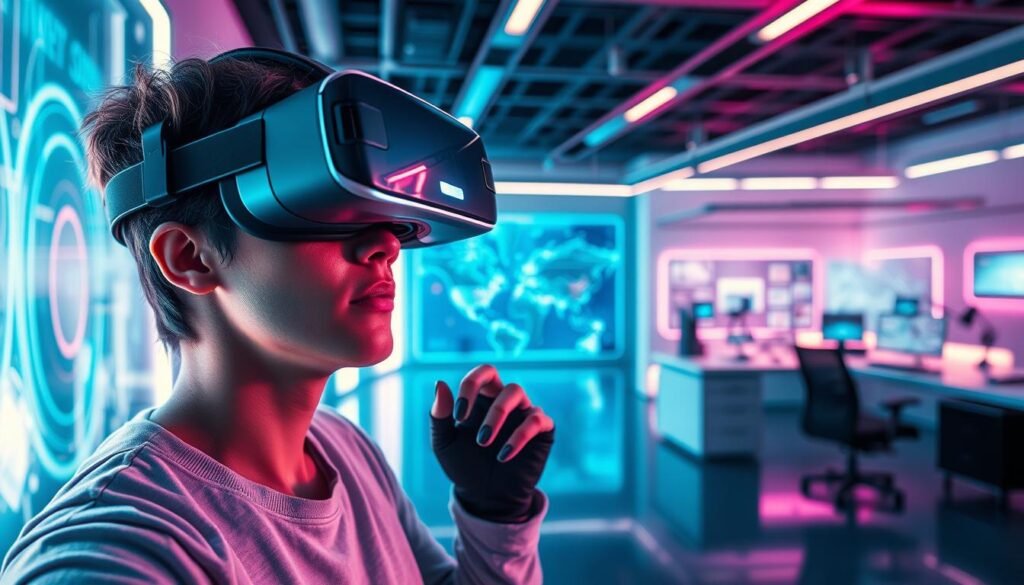
Learning by doing: classrooms, simulators, and surgical training
Education gains when students repeat procedures in a safe setting. Flight simulators and surgical rehearsals let learners practice with immediate feedback.
That lowers risk, saves resources, and boosts confidence before people try tasks in the real world.
Video games and immersive entertainment experiences
In entertainment, video games put players inside virtual worlds that respond to movement and sound. Headsets make scenes and images feel close and alive.
Architecture, real estate, and collaborative design
Design teams use immersive walkthroughs to check scale, light, and materials. They manipulate objects and images together, so decisions happen faster and with fewer revisions.
Workplace applications: telepresence and virtual collaboration
Industry teams reduce travel by meeting in shared spaces for co-design, annotation, and training. Maintenance drills and remote assistance deliver clear ROI.
- I highlight how education benefits from repeatable simulations and instant feedback.
- Training examples show lower risk and cost for complex skill-building.
- Entertainment and games create engaging narratives and active play.
- Design and workplace use speed decisions and connect distributed teams.
“Hands-on practice in simulated environments is a powerful multiplier for skill and team alignment.”
Benefits, Challenges, and Safety in Today’s VR Environment
I’ve seen how hands-on practice in a simulated setting turns awkward tasks into calm routines. That strength matters most for training and education. Repeating a procedure in a controlled environment builds skill without real-world risk.
What it does best: practice, repetition, and risk-free exploration
Safe repetition lets learners build muscle memory and confidence. Complex tasks—surgical steps, flight checks, or emergency drills—become second nature when you can repeat them without consequences.
Common hurdles: cost, motion sickness, access, and computing power
High-quality gear and content often carry steep upfront costs. Some people also feel motion-related discomfort when perception and visuals conflict.
Smooth visuals need enough CPU/GPU power and memory. Uneven global access means not every community can use these systems yet.
Healthy use: breaks, calibration, and gradual exposure time
Simple safety habits help users avoid fatigue and sickness. I recommend short sessions at first, regular breaks, and careful IPD and strap calibration before each use.
Check comfort ratings and user reviews for apps. Start with low-motion scenes and increase session time slowly to improve tolerance.
“Start small, calibrate carefully, and treat each session as a step toward longer, smoother experiences.”
- Practice safely: use repeatable scenarios for skill building.
- Watch tech needs: good hardware prevents lag and motion issues.
- Follow a safety checklist: room setup, fit, calibration, and timed breaks.
What’s New and What’s Next: Development and Industry Trends
I’m seeing steady progress in optics, haptics, and sensing that changes what immersive systems can do.
Advances in headsets, haptics, and vision systems
Displays are sharper and lighter, with higher resolution and better HDR that reduce eye strain and improve images. Tracking and sensor fusion make room-scale setups easier to use and safer.
Haptics moved beyond rumble. New controllers and gloves deliver more precise force and touch cues so interactions feel real.
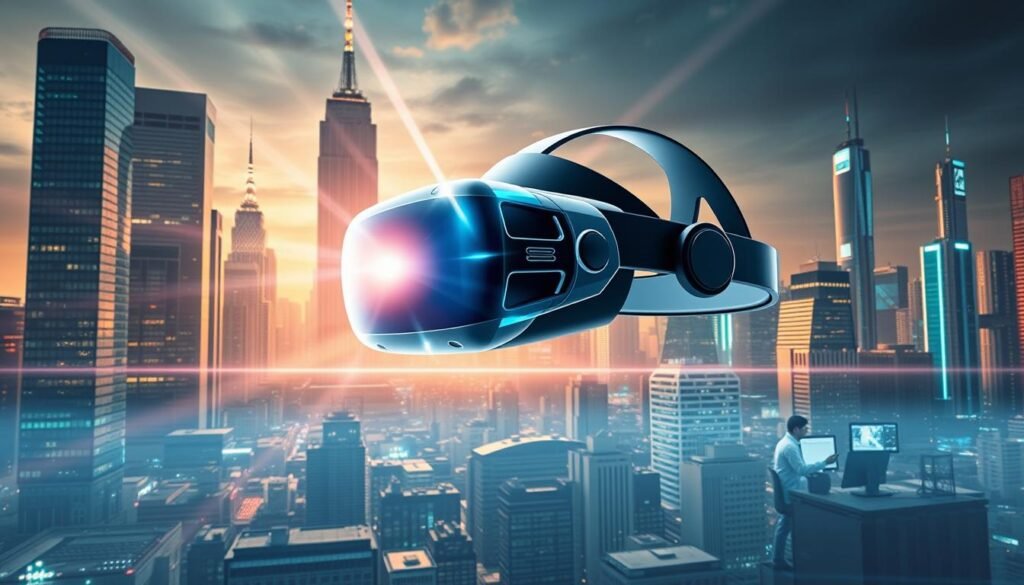
Market momentum: platforms, content, and broader applications
Device launches and platform growth drive content expansion. Pico 4 Ultra is set to launch in China, Quest 3 just passed one million users, and rumors point to a Quest 4 in later roadmaps.
That momentum pushes more training, collaboration, and entertainment apps into stores. Investment follows useful applications in enterprise and education.
“Transparent testing and safety focus will decide how broadly these systems are trusted and used.”
| Trend | Impact | Example | What to watch |
|---|---|---|---|
| Optics & displays | Sharper images, less fatigue | Higher-res HDR panels | Resolution, compression, HDR tuning |
| Haptics | More convincing touch | Advanced gloves, adaptive controllers | Latency and feedback fidelity |
| Tracking & passthrough | Safer mixed use | Improved depth sensing | Room mapping, occlusion accuracy |
| Market & content | Richer libraries, more apps | Pico 4 Ultra, Quest 3 growth | Platform policies, safety research |
Conclusion
Here I summarize the practical steps and the core ideas that will help you start safely and confidently.
Virtual reality delivers immersive, interactive environments where users can learn, practice, and explore without real-world risk. Focus on comfort: set your fit, calibrate lenses, and take regular breaks.
Keep your first sessions short and pick low-motion apps. That approach makes the early learning curve gentler and lets presence form naturally in the new world you enter.
The biggest early wins show up in training and education: focused drills, repeatable scenarios, and clear feedback speed skill building for people and teams.
I encourage you to revisit gear and safety sections as you upgrade or expand your use. Start slow, listen to your body, and enjoy exploring this evolving world at your own pace.
FAQ
What do you mean by a beginner’s guide to virtual reality?
I explain the basics so anyone can start exploring immersive tech. I cover core hardware like head-mounted displays and motion controllers, essential software elements, types of systems, and simple setup tips. My aim is to help you understand how computer-generated environments create presence and how to get started safely and comfortably.
How do you define a computer-generated environment and presence?
I describe a computer-generated environment as a simulated world rendered by a computer where visuals, audio, and inputs combine to create a sense of “being there.” Presence is the feeling that your mind accepts the simulated scene as real for the moment, driven by low latency, high frame rates, convincing audio, and accurate tracking.
How does immersive tech differ from augmented and mixed systems?
I explain that augmented systems overlay digital images on the real world, while mixed systems let virtual objects interact with physical surroundings. Fully immersive setups replace your surroundings with a rendered environment, blocking external cues to deepen presence.
What core hardware should beginners know about?
I cover head-mounted displays, motion controllers, sensors, and data gloves. Headsets provide visual and audio immersion; controllers and gloves let you interact with objects; sensors handle positional tracking. I also touch on play area setup and compatibility with computers or consoles.
What software and inputs drive immersion?
I outline how real-time rendering, spatial audio, and synchronized inputs—like hand tracking and haptics—combine to sell the illusion. Good content design, optimized images and video, and stable frame rates matter as much as the hardware.
What should I know about tracking: 6DoF vs. 3DoF, latency, and field of view?
I explain that 6DoF tracks position and rotation for full movement, while 3DoF tracks rotation only. Lower latency and higher frame rates reduce motion sickness. A wider field of view increases immersion but can demand more processing power.
Why does presence affect comfort and motion sickness?
I point out that mismatches between visual motion and your inner ear signals cause discomfort. Smooth tracking, proper calibration, and gradual exposure reduce symptoms. Design choices—like limiting artificial locomotion—also help.
What types of systems and experiences exist?
I list non-immersive options (desktop-based), semi-immersive setups (simulators and large displays), and fully immersive headsets. Each suits different goals: education, training, entertainment, or industrial use.
How do AR and MR overlays compare to full immersion?
I note AR overlays information or images on the real world, great for guidance and maintenance. MR goes further by allowing digital objects to interact with physical environments, useful in design and collaborative workflows. Full immersion isolates you for focused simulations and entertainment.
How do I choose a head-mounted display and compatible system?
I recommend matching the headset to your needs—PC-tethered headsets for highest fidelity, standalone units for convenience, and console options for gaming. Check system requirements, controller types, and content libraries before buying.
What comfort and setup tips help first-time users?
I suggest adjusting straps and IPD, balancing weight, using a soft face gasket, and ensuring good ventilation. Create a clear play space, update firmware, and start with short sessions to build tolerance.
How is this tech used in education and training?
I describe immersive learning in classrooms, flight and surgical simulators, and hands-on practice that scales safely. Repetition and risk-free scenarios accelerate skill acquisition and boost retention.
What about gaming and entertainment experiences?
I highlight interactive titles, 360° video, and location-based attractions that deliver memorable experiences. Controllers, haptics, and motion systems expand how games engage your senses.
How do architects and teams use these systems for design and collaboration?
I explain that immersive walkthroughs let clients explore spaces before they exist. Remote teams use telepresence features to review models together, improving decision speed and reducing rework.
What workplace applications are most promising?
I point to remote collaboration, virtual meetings with shared 3D content, and training simulations for hazardous tasks. These uses can lower travel costs and improve operational safety.
What are the main benefits of using these systems today?
I emphasize practice without risk, scalable training, increased engagement, and new creative possibilities in entertainment and design. They let people rehearse rare scenarios and learn by doing.
What challenges should I expect—cost, motion sickness, and access?
I warn about upfront hardware costs, the need for capable computers in some setups, and potential motion sickness. Content availability and accessibility remain hurdles, but prices and software ecosystems keep improving.
What safety and healthy-use guidelines do you recommend?
I advise regular breaks, proper calibration, limiting session lengths at first, and adjusting comfort settings. Supervise children, and consult a doctor if you have vestibular or vision concerns.
What advances are shaping the next generation of headsets and haptics?
I mention improvements in display resolution, eye tracking, lighter optics, and richer haptic feedback systems. Better vision systems and faster processors promise more convincing experiences and broader adoption.
How is the market evolving for platforms and content?
I note growing investment from major tech companies, expanding app stores, and cross-platform tools that make development easier. More industry-specific applications are emerging in healthcare, education, and enterprise.
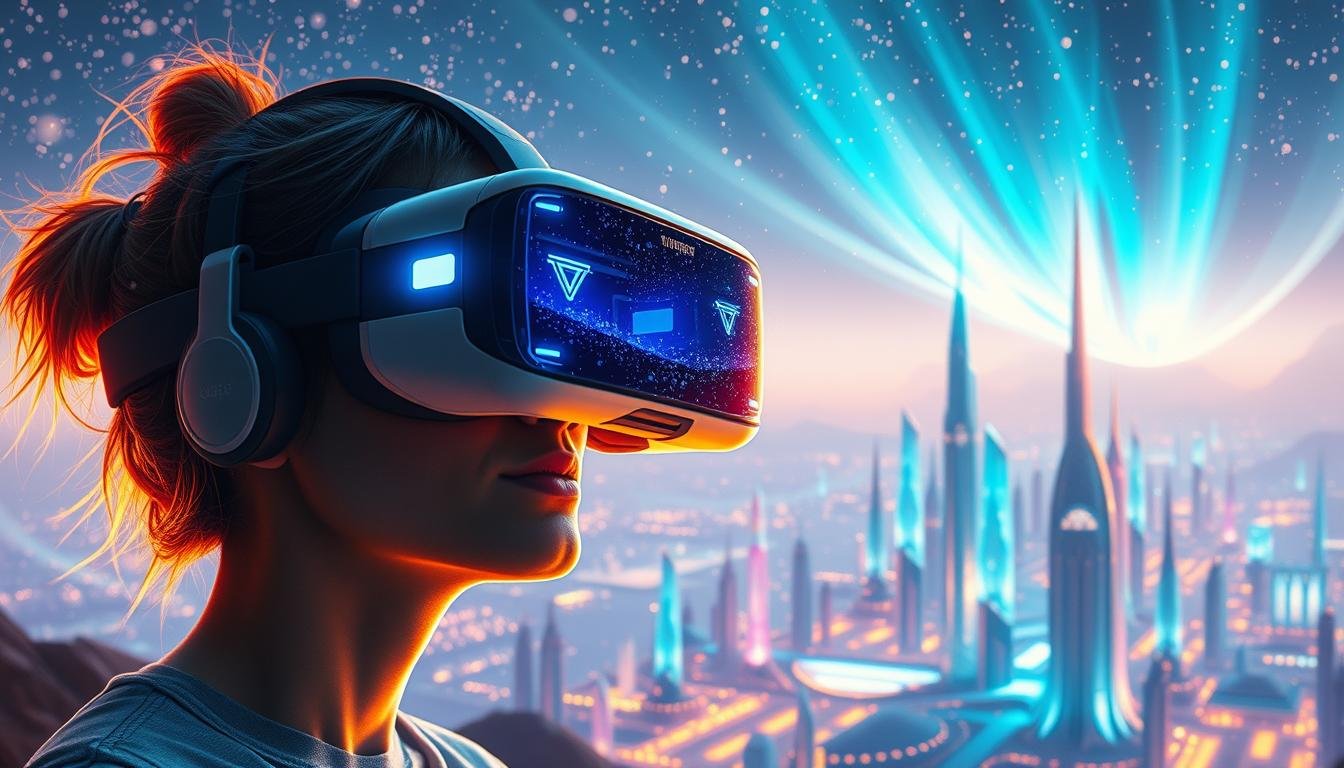



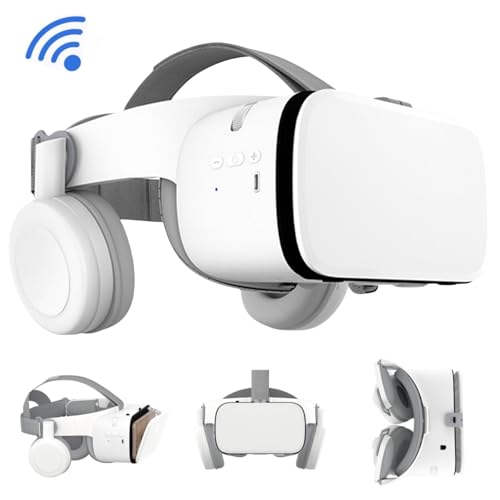




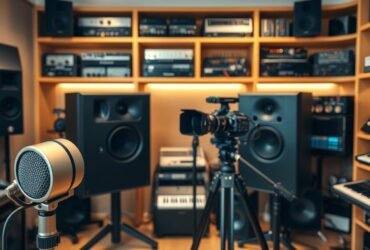
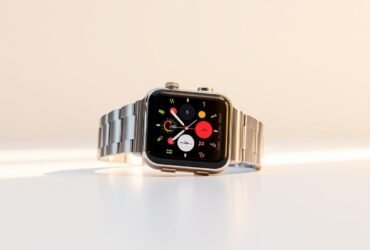

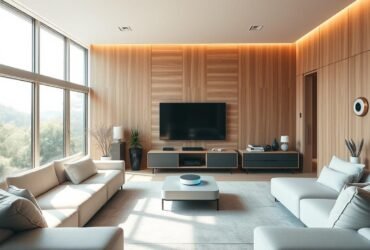
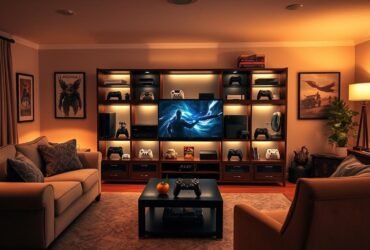
Leave a Reply